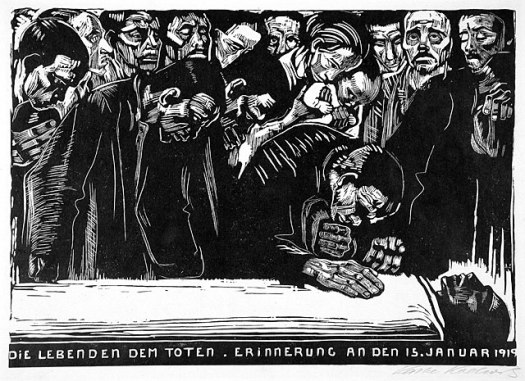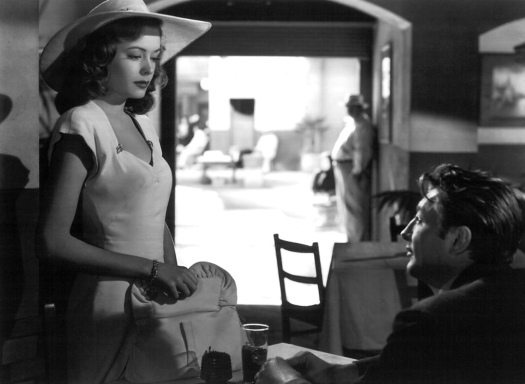From the rise of crimes due to prohibition during the 1920’s, through the poverty caused by the Great Depression in the 1930’s, until the blurry reasons why America entered the Second World War and the growing fear of the USSR holding the atomic bomb, the country went through a lot of change, with no longer clear gender roles and a lot of psychological suffering. Change became the first cause of an irrational anxiety and paranoia among the population. This was translated in movies, and in film noir movies in particularly. Those were the result of a society whose principles and values were no longer unquestionable.

In 1946, Nino Frank, a French movie critic, attributed the name of “film noir” to the wave of American dark crime films, that appeared during and after World War II. Actually, they proliferated a lot between the 1940’s until the end of the 1950’s, and were characterized by specific features, linked to what inspired those films to be constructed the way they were. Indeed, film noir is the fruit of the German expressionism and hard-boiled novels, or more commonly called, pulp fictions. Film History students of the University of Florida said on their online blog, The Museum of Film History, that “expressionist used the visual arts to create a look into the emotional and psychological state of being by use of distorted images and irregular shapes.” Thus, some scenes in 1922 Friedrich Wilhelm Murnau’s Nosferatu, such as when Count Orlok climb up the stairs and his nonhuman shadow is being projected on the wall, is pretty much symbolical of film noir. A low key lightening, or chiaroscuro, introduced by the German paintings and movies, provided those types of shadows and this technique will be strongly used in future American film noir movies. As for the pulp fictions, some authors,such as Dashiell Hammett, Raymond Chandler, James M. Cain or Cornell Woolrich were icons of the detective novels in the 1920’s and 1930’s, and a lot of their work was later adapted in movies; Hammett’s Maltese Falcon in 1941, is one the most famous, directed by John Huston with Humphrey Bogart and Mary Astor, later symbols of anti-hero, and femme fatale of those movies. But also, James M. Cain’s Double Indemnity put into the screen by Billy Wilder in 1944 is really emblematic. But film noir gathers also other characteristics such as, filmmakers tightened by low budget, black and white photography, and story related elements such as a narrative. Tim Dirks said on his website film site about film noir that “storylines were often elliptical, non-linear and twisting”, taking place in cities such as New-York or San Francisco, full of “murky and dark streets”, where it rains a lot and with characters living in low rent apartments or hotel rooms. And to generalize, the themes approached are often close to sex, violence and crime perfectly illustrated by Touch of Evil directed by Orson Welles in 1958. However, directors were bound from 1934 to 1966 by “the Motion Picture Production Code commonly called the Hays code which censored taboo subjects” as mentioned John P. Hess from FilmmakerIQ in a video called Introduction to Film Noir. Tim Dirks adds that “film noir is not a genre, but rather the mood, style, point-of-view, or tone of a film”, which reflects a historical time period.
Indeed film noir is the reflection of a dark and pessimist period in the United States of America. Fear has taken every space in citizens’ minds, and in different shapes. The A-bomb, known between the hands of the Russian communists was threatening, and was the catalyzer of movies like The Lady from Shanghai directed by Orson Welles in 1947. Political turmoil is rising from the traumas caused by the atrocities of the war, including genocides and rise ofdestructives weapons. J. J. and S. L. M. Blaser (2008) said in their essay “noir films generally question social and governmental institutions”, and according to Westcombe (2003), they narrate a “post war malaise” of the end of the 1940’s which was a combination of disappointment and frustration. It was actually a wave of disenchantment that led to “questioned the fundamental optimism of the American dream” as said by Mayer (2007). All this, created characters, heroes, or more anti-heroes, who had a not so good relationship with their society, and felt the need to escape it, just like the protagonist of Killer’s Kiss directed by Stanley Kubrick in 1955, felt the urge to leave his lousy apartment and actual city where murders and corruption reigned. The feeling of entrapment highlights the need of putting into action, doomed heroes, left to Westcombe ‘s “noir’s spider web of fate”. Those heroes were most of the time psychologically troubled, developing mistrust towards everything, and subject to paranoia and confusion, reflection of the war’s psychological consequences on the American population.
However, it is important to clarify one aspect belonging to those film noir movies; the hero was always a men. Women were eroticized and villainized; a misogynistic view was adopted, and a message pro- “nuclear” family was conveyed. Indeed, after the men returning from war, women, who were, during the whole time, in the workforce and doing what their husbands were doing before the war, had a hard time renouncing their jobs and, sort of, independence. This frightened Americans. The women had to go back to her housing chores and duties, while men returned to their status of breadwinners. There was a clear crisis of culture, where there was an urge to find a place for women. Film noir movies were here to question but also promote an ideal; the “femme fatale”. The spider woman, as named by Westcombe, was dangerous, source of problems, and here to distract the hero. Film noir movies, made sure to punish “bad” women, just like they did in The Maltese Falcon or Stanley Kubrick’s The Killing directed in 1956. As J.J. and S.L.M. Blaser said “these women are destroyed, punished, or converted to more traditional roles after learning that their independence was a mistake”. “She reinforces film noir’s fatalism” adds Westcombes, and might be compared to “the vamp” of the 1920’s, threating the concept of “nuclear” family. Therefore, it is showed what woman is supposed to be; supporting the men, being a little ignorant, and focusing on her house and children. The hero is supposed to resist to the femme fatale and choose his stable women, or he will be punished also, which led us to think that if you play your role you’ll be okay, otherwise, you’ll be punished. This is the reason why, it is rare to have happy endings in noir films. Marginal, murky streets, and dark cities, are compared to the uniformity of suburbs, and a “cult of domesticity” is conveyed. Noir films were established to scare the viewer of a change in gender roles and showing how women’s independence could be harmful and destroy the family institution, basis of the society.
Film noir, is the creation, fruit, of all fears American citizens experienced from the 1940’s to the 1960’s. Dark period of trouble, disorientation and trauma, those movies translate the consequences of change in their country, on citizens’ mind, adding the mistrust held against the government and the corruption maintained in an underworld. From different influences, filmoir, never died, and gave birth to contemporary movies, such as Pulp Fiction directed by Quentin Tarantino in 1994 or Sin City directed by Robert Rodriguez in 2005.
Reference list:
Blaser J, J. & Blaser S. L. M. (2008). No Place For A Woman: The Family In Film Noir. Retrieved from http://www.filmnoirstudies.com/essays/no_place2.asp
Bousel, M. (Producer), Kubrick, S. (Producer) & Kubrick, S. (Director). (1955) Killer’s Kiss [Motion Picture]. United States: United Artists.
DeSylva, B. (Producer), Sistrom, J. (Producer) & Wilder, B. (Director). (1944) Double Indemnity [Motion Picture]. United States: Paramount Pictures & Universal Studios
Dieckmann, E. (Producer), Grau, A. (Producer), & Murnau, F.W. (Director). (1922) Nosferatu [Motion Picture]. Germany: Prana Film.
Dirks, T. Film Noir. Retrieved from http://www.filmsite.org/filmnoir.html
Harris, J. B. (Producer) & Kubrick, S. (Director). (1956) The Killing [Motion Picture]. United States: United Artists.
Hess, J.P. Introduction to Film Noir. Retrieved from http://filmmakeriq.com/lessons/introduction-to-film-noir/
Horsley, L. (2002). The Development of Post-war Literary and Cinematic Noir. Retrieved from http://www.crimeculture.com/Contents/Film%20Noir.html
John Abbott. Influences of Film The Noir. Retrieved from http://eng3122.wordpress.com/group-6-main/influences-2/influences-of-film-noir/
Mayer, G. & McDonnell, B. (2007). Encyclopedia of Film Noir. Connecticut: Greenwood Press
Schmidlin, R. (Producer), Zugsmith, A. (Producer), & Welles, O. (Director). (1958) Touch of Evil [Motion Picture]. United States: Universal Pictures
Wallis, H. B. (Producer) & Huston, J. (Director). (1941) The Maltese Falcon [Motion Picture]. United States: Warner Bros.
Welles, O. (Producer) & Welles, O. (Director). (1947) The Lady From Shanghai [Motion Picture]. United States: Columbia Pictures.
Westcome, R. (2003). What is this thing called film noir anyway?. Retrieved from http://www.crimeculture.com/Contents/RW-ThingCalledNoir.html



